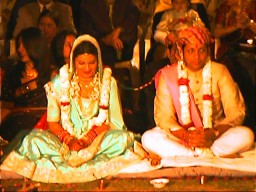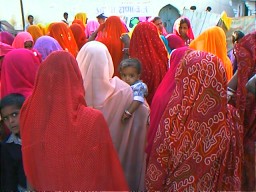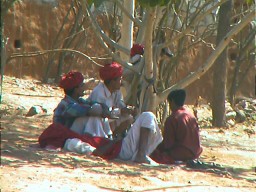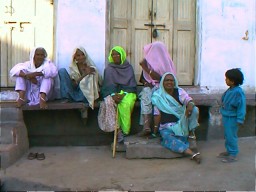|
All images and text are copyright protected. Contact
|
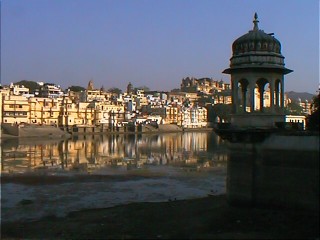 Udaipur, the City of Lakes and Palaces, the City of Sunrise, the most romantic city in Rajasthan is also the most southern city in Rajasthan, western India. The narrow winding lanes lined with temples, bazaars, quaint buildings with curious windows and choked with auto-rickshaws, scooters, cows, barrows and tourists are picturesque indeed. The tourists love Udaipur and there is a glut of rooftop restaurants and guesthouses, Internet cafes and tiny souvenir shops, scooter rentals and money-changers catering to their foreign needs. I open all the windows of my room which gives me a panoramic view of an impossibly beautiful Lake Pichhola and the Lake Palace in the dawn. Below my windows are thirteen temples and.the ghats where Hindus worship, bathe and wash their clothes. My windows are at treetop level and I can look straight into the faces of several monkeys chattering and racing about. "This," think I, "is the real India! The India that exists only in films like Siddhartha, Kama Sutra and James Bond's Octopussy. This is what India ought to look like in real life." And it does. 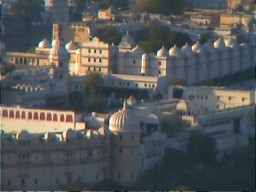 Like a painting, the silhouetted Monsoon Palace clings to the hilltop at sunset. The City Palace, the largest palace in Rajasthan, is as large as, well, a city. The many gardens were designed to rival Nirvana. Even ordinary houses have intricate stone fretwork for balconies. Better, the Rajasthani villagers wear traditional white kurta dhotis and scarlet turbans and colourful salwar kameez. Even better, the hilly lanes are littered with cow dung and the houses are painted slapdash prettily in white, blue and green. How much better can it get? Plenty. I arrive in late winter, early spring, perfect weather when the days are warm and the nights cool. Summer sometimes reaches a searing 43 0Celsius though in this climate on the edge of the Thar Desert it is a dry heat. If spring is the best time of year to be in Udaipur, then sunset is the best time of day. Rajasthani sunsets aren't as spectacular as, say, the flaming reds of the Caribbean. But these are certainly more idyllic when the temples and palaces are limned against a horizon in hues of pinks and blues. The view overlooking Lake Pichhola is addictive but the one from the hill at, the aptly named, Sunset Point with all the lakes and the city spread out below, is sublime.
This is the month for marriages. I hear the drums, brass instruments and singing of wedding processions three or four times a day. The groom rides by dressed resplendently in rich gold tunic and turban with a sword thrust in his sash, his horse decked in beads, fringe and glitter and accompanied by several boys bearing lamps to illuminate the way. The elaborately dressed bride rides in a carriage drawn by a horse equal to the groom's escorted by her procession of gaily dressed women carrying pots of water and singing songs of happiness and good fortune. Late in the night, the festivities continue with food and the sounds of merriment and music drifting over the lakes. 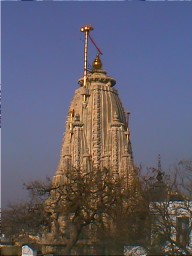 Jagdish Temple Down below in the congested bazaars are the streets of jewellers, minature painters, shoemakers, tin and coppersmiths, spice merchants, garment vendors, sari specialists, rope and twine sellers, vegetable and fruit stalls and basket weavers who squat working on jute bags. In front of Jagdish Temple is a collection point for victims of the Gujarat earthquake and all over town are bags of ghulal powder in red, yellow, blue, green and pink as the city prepares for Holi, the most jubilant festival on the Udaipur calendar. Due to the equal amounts of Muslims and Hindus, cows and pigs roam the streets fearlessly. Rajasthani history is replete with stories of wars between the Rajput rulers and later, against the Mughals. Legends abound also of women and children of the defeated warriors choosing immolation over surrender. In 1568 Maharaja Udai Singh II founded Udaipur among the Aravalli Hills and built his colossal City Palace and city walls against the invading Mughals. Though he was successful in keeping out the Mughals, over the next century their influence penetrated the city to merge with the arts particularly in the realms of minature painting and their desert music, both hybrids of Hindu and Muslim/Persian forms.
I envy the Udaipurians that they, unlike the tourists, can live in this fairytale paradise forever except that, having lived here all their lives, they no longer appreciate the beauty of Udaipur. The other big difference is that the tourists are here to have a good time and spend dollars while the Udaipurians try to catch those falling dollars if they can. Unfortunately the tourist season isn't booming as it should due to the recent earthquake in nearby Gujarat which frightened many into other destinations and the tourist season is as dry as the lakes. 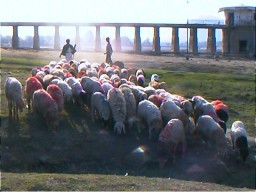 It hasn't rained properly here for the past five years and the lakes are now only quarter full. Grass grows on the lake beds, cracked and drying in the sun. The farmers pray to the goddess Indra
Dev for rain so that they may live. For them, watching their brown fields is like watching their blood drain away.
It hasn't rained properly here for the past five years and the lakes are now only quarter full. Grass grows on the lake beds, cracked and drying in the sun. The farmers pray to the goddess Indra
Dev for rain so that they may live. For them, watching their brown fields is like watching their blood drain away. Sanjay, 15, is bright, good-looking and resourceful. "I'm a Meena caste," he says. "It is a good caste which means my chances for a good job are not bad." The Hindustan Times 8 page Matrimonial Classifieds is divided into "Grooms Wanted" and "Brides Wanted" which are further subdivided into castes: Agarwal, Brahmin, Jain/ Vaish, SC/ ST, Manglik, NRI, Khatri and Sikh. A typical ad runs: "Manglik alliance invited from extremely beautiful, fair, educated, slim girl belonging to high status respectable family for business class family boy 28/ 180 handsome, fair, educated, having his own business. Correspond with full details and photograph (returnable)." "Can you worship in a Jain temple?" I ask Sanjay. "No, Jain temples are only for Jains," he replies. "Do you believe in karma, that what you do in this life will affect your later lives?" "No." "Do you believe in reincarnation?" "No." 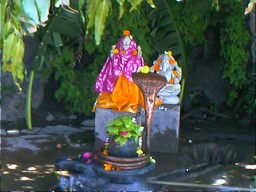 On Maha Shivaratri, a Hindu festival celebrating Shiva's birth, hundreds of Hindu Udaipurians make a pilgrimage to Eklingi, the nearby temple complex dedicated to Shiva. Udaipur is dressed up in
glitter and finery for the occasion. At every shrine we are given prasad (consecrated food) and a dollop of lassi (yoghurt). Sanjay becomes light headed after one offering of lassi mixed with bhang (marijuana).
On Maha Shivaratri, a Hindu festival celebrating Shiva's birth, hundreds of Hindu Udaipurians make a pilgrimage to Eklingi, the nearby temple complex dedicated to Shiva. Udaipur is dressed up in
glitter and finery for the occasion. At every shrine we are given prasad (consecrated food) and a dollop of lassi (yoghurt). Sanjay becomes light headed after one offering of lassi mixed with bhang (marijuana)."In the shrine," he says, "the black stone of Shiva is often covered with bhil leaves to make him happy. The other gods are his wife Parvati, his son Ganesh and the snake, coiled around his neck, is Sheshnaag." Dinners at Sanjay's home are usually a vegetable or potato curry and chapatis with a sweet rice or halva (carrot and milk) and water pumped from the well. Despite the terrible admonition in my guide book about not using the left hand to eat, Sanjay eats with both hands, or sometimes spoon, and is not bothered by my doing the same. My first time, as the guest, I was served first and allowed to eat first but seeing that I was uncomfortable with this, Sanjay joined me in the meal. The men always ate before the women and though Sanjay and I eat at a table with chairs, the family prefers sitting on a carpet. 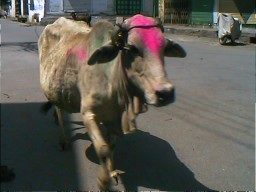 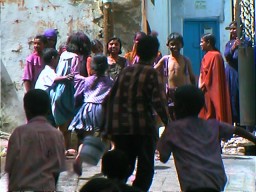 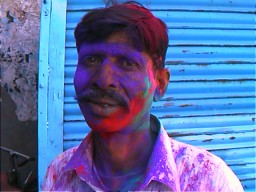 In Trinidad the Hindu festival Holi is called Phagwa (Phalgun is the month corresponding to February / March) but in India Holi extends over two days. "The first day is dedicated to Prahalad, the young son of a king," says Sanjay. "Prahalad worshipped Vishnu who gave him immortal life. The boy's father, thinking himself a god, ordered that Prahalad worship him, the king, instead. The boy refused and the king instructed a soldier to throw the boy over the cliff into the sea. This was done but the boy, saved from drowning by the god Vishnu, returned to the palace. The king's sister, certain that she was immortal and the boy was not, suggested that both she and the boy be burnt alive. She was killed in the flames and the boy was saved once again. This time Vishnu came to the palace in the form of a human with a lion's head and claws and killed the king by ripping open his stomach with his claws. Prahalad inherited the throne and the people celebrate his devotion to Vishnu by burning bonfires on the first night of Holi." 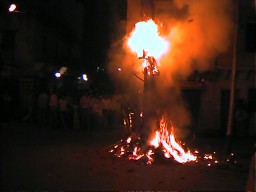 In the night, to the cries of, "Holi
hai!" and prayers, tall bonfires are lit scorching the electrical wires above.
In the night, to the cries of, "Holi
hai!" and prayers, tall bonfires are lit scorching the electrical wires above. The following day is the day of colour when everyone covers the town and everyone in it with red, blue, yellow, green and pink powder or ghulal. Trinidadians say "abeer" which is an Urdu word meaning the same as ghulal. It is a festive time when all businesses are closed and people are free to relax and be merry. "Holi ki shubhkaamna," people greet one another. I say to you Happy Holi. Raceandhistory.com | Howcomyoucom.com | Trinicenter.com | TriniView.com Another 100% non-profit Website serving poorly represented communities. Copyright & Disclaimer. - - Privacy Policy --Designed & maintained by S.E.L.F. © 2002 TriniView.com |

